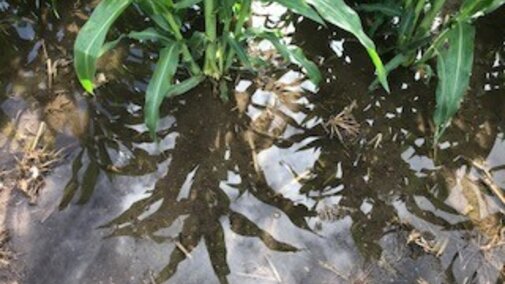Green snap from June 28 storm that went through northeast Nebraska, this pic is from northern Washington County. #cornwoes @UNL_CropWatch pic.twitter.com/95sGQOBSvz
— Nathan Mueller (@croptechcafe) June 29, 2018
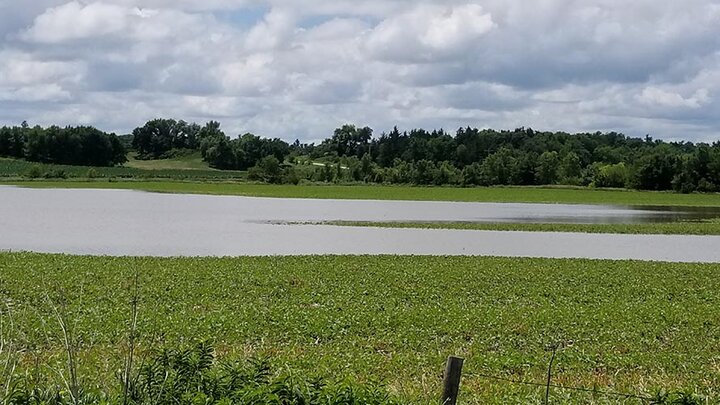
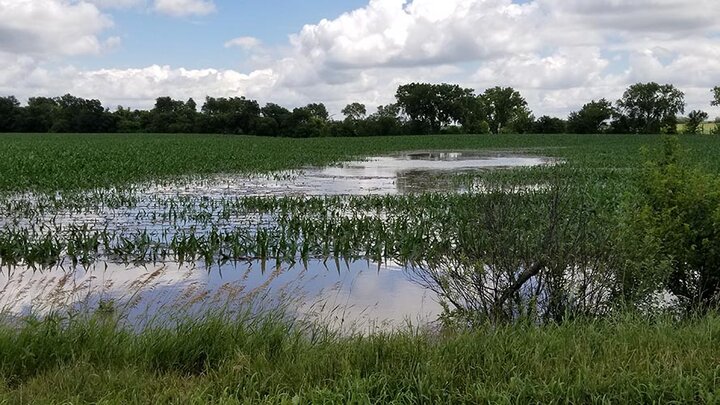
Figures 1-2. Flooding in soybean (left) and corn fields in western Colfax County along Shell Creek from heavy rains over the last week. (Photos taken June 26 by Aaron Nygren)
Aaron Nygren, Extension Educator in Colfax County: Heavy rains of 6-10+ inches fell in parts of Cuming, Colfax, and Platte counties over a 24- to 36-hour period on June 24-25. As a result, many lowland areas on the creeks downstream are experiencing flooding. These include Shell Creek, Maple Creek, and Logan Creek. (6/26/18)
The map (Figure 3) shows observed precipitation of 2 to more than 10 inches in the seven days ending June 26 in this multi-county area of northeast Nebraska.
Larry Howard, Extension Educator in Cuming County: After heavy rains in the last week in northeast Nebraska (Figure 3), particularly June 25-26, we're seeing lowland flooding along streams, creeks, and in fields. Livestock producers should be managing their holding ponds according to their permits with the Nebraska Department of Environmental Quality (NDEQ). If there is a discharge, remember to maintain records and report it to NDEQ as soon as possible. For more information see Emergency Management of Holding Ponds during Wet Weather, a guide developed by Amy Schmidt, Nebraska Extension livestock bioenvironmental engineer, in cooperation with NDEQ. (6/27/18)
Also see Information and Resources for Flooded Fields with more flood photos.

What makes it a 100-year storm event?
Tyler WIlliams, Extension Educator in Lancaster County: For the West Point area in Cuming County in northeast Nebraska, getting 6-7 inches of rain in 24 hours on June 25 qualified as a 100-year storm.Often it's difficult to determine which storms meet this criteria, given data is reported by date and 24-hour storm events often extend across two dates (for example, from noon one day to noon the next). That said, I found several 100-year events in the last three years in the four-county area including Dodge, Washington, Burt and Cuming counties, based on precipitation records from COOP stations and CoCoRaHS stations:
- West Point (6 miles north) — 6.5 inches of rain on 6/25/2018
- Lyons — 6.36 inches on 9/16/2016
- Fremont — 7.12 inches on 6/18/2016
- Blair (5.2 miles south) — 6.19 inches on 8/24/2016
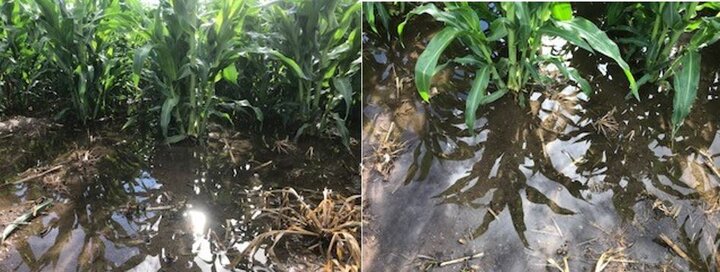
Megan Taylor, Extension Educator in Platte County: It has been wet here in Platte, Nance, and Boone counties. Yesterday Columbus received around 4 inches of rain, Boone County got 4 to 6 inches, and Nance County recorded about 4 inches. This morning several fields had 0.5-1 inch of standing water. There was hail in the northern most part of Platte County and southern Madison County. Reports indicate severe damage to beans and stripping of leaves on corn. (6/26/18)
Sarah Sivits, Extension Educator in Dawson County: The rain was a blessing, but there was a lot of it. First cutting of alfalfa has been baled and second is growing really well. Corn, including seed corn, is anywhere from V6 to V11-V12 and really growing fast. Volunteer corn is an issue everywhere. We're seeing a little lodging and leaf damage from recent storms, but otherwise, crops are looking pretty good. Soybeans are are V3-4 to flowering. I’ve gotten three calls reporting soybean leaf cupping from possible dicamba drift, and in scouting this week found adult dectes stem borer in soybean. Wheat has headed and a field by Kearney turned last week. (6/26/18)
Jennifer Rees, Extension Educator in York County: Corn is at V9-V12 and overall looks good, except for some hail damage. Soybeans are mostly at beginning flower to full flower. All the drought stress in south central Nebraska has taken a toll on wheat; some started harvesting drought-stressed fields last week in Thayer County. Moisture was really welcome, but in non-irrigated fields, it’s still basically dry at the 3-4 foot depth. I'm getting calls on suspected off-target dicamba movement. Many have found this video on diagnosing damage helpful. (6/26/18)
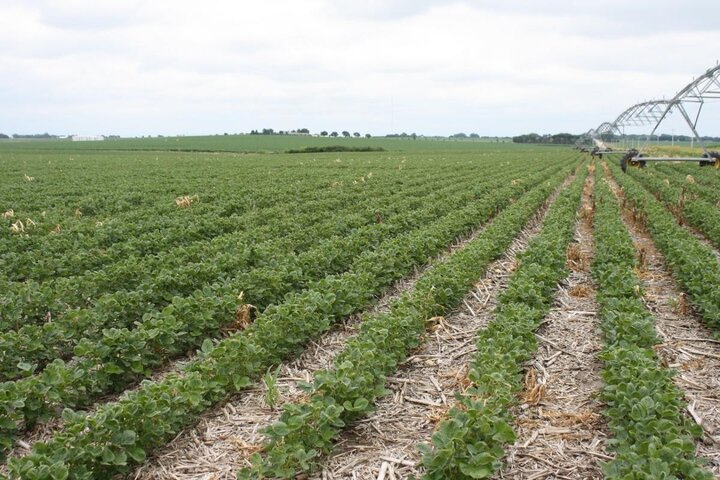
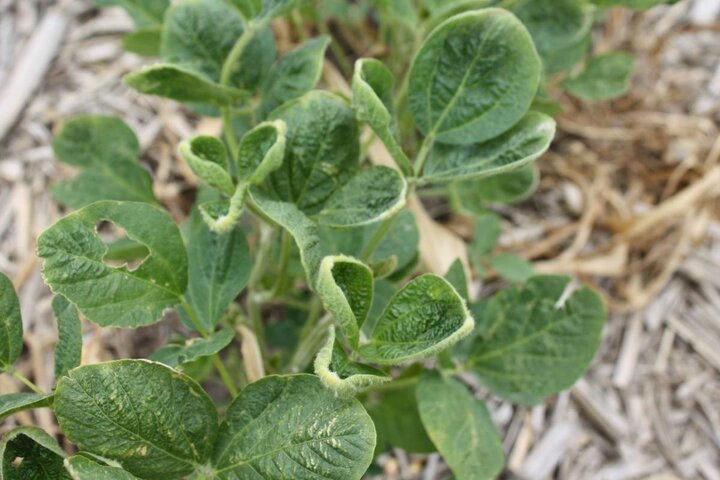
Ron Seymour, Extension Educator in Adams County: Rainfall in the county has varied from 1.8 inches in Hastings to 7-8 inches in other areas. Crops are growing well. Corn is from V4 (replanted field) to V11 and looking good. Soybeans are from V3 to flowering. We’re starting to see some suspected dicamba injury to gardens and trees. Wheat is turning color and starting to mature and harvest is likely to start here just after July 4. (6/26/18)
Tyler Williams, Extension Educator in Lancaster County: We’ve gotten some timely rains with most of the counties in this area getting 3-5 inches. However, in far southeast Nebraska they haven’t gotten the rains and are getting a little nervous. Generally corn looks good and is at V10 with a couple fields shooting a flag leaf. Soybeans are flowering. Weeds seem to be under control for the most part. The biggest problem is volunteer corn. I have gotten some complaints of suspected off-target dicamba injury to trees, gardens, and houses. (6/26/18)
Steve Melvin, Extension Educator in Merrick County: Merrick and Hamilton counties have have received some good rains and crops are growing well. Volunteer corn is a huge issue though and these levels of volunteer will impact yield come fall. A grower is Nuckolls County said he’s likely to start harvesting wheat later this week or early next week. (6/26/18)
Keith Glewen, Extension Educator in Saunders County: At the Eastern Nebraska Research and Extension Center near Mead we got 5.3 inches of rain June 18-26. Areas north, northwest and southwest of us got even higher amounts. I can’t remember a more beautiful crop than this year. The uniformity and color of corn is breathtaking. It’s likely due to slower nitrification during the cold spring. Soybeans are looking dynamic too. There are some problems with volunteer corn. With this wet weather, volunteer corn is likely to get out of control. (6/26)
Amy Timmerman, Extension Educator in Antelope County: As with other locations, conditions here are wet. In the last week we’ve gotten 2 to 5 inches, depending on location, and yesterday got another 1.5-2 inches. Crop growth stages are very diverse as some corn was planted last week. Corn is from germination to V10 and soybeans are from germinating to beginning flowering. Soybean stages are similarly diverse. Generally, crops are looking good. The first cutting of alfalfa went well, but had a significant number of alfalfa weevils. Some growers are applying the first shot of nitrogen on alfalfa under irrigation due to cloudy weather and N leaching. (6/26/18)
Wayne Ohnesorg, Extension Educator in Madison County: Most planting in this area wrapped up the first full week of June and crops look really good. We're very wet and it looks like more rain is coming this weekend. We received 4.1 inches of rain June 17-23; other areas nearby had 4-6 inches with some areas getting 5-6 inches (and a few spots with 8 inches) June 24-25. With all this rain, we’ll see what happens with the nitrogen. (6/26/18)
